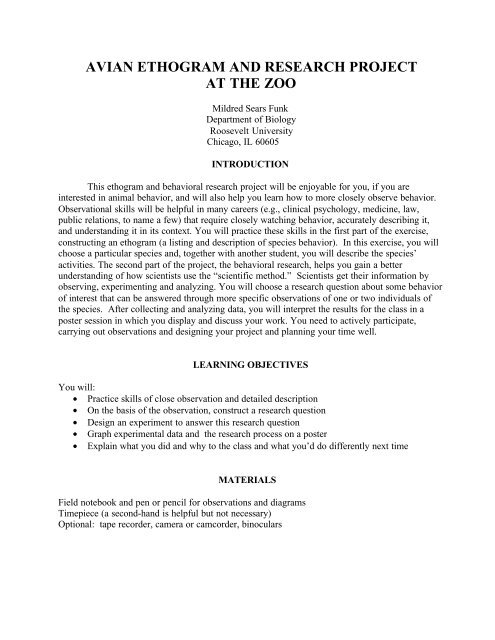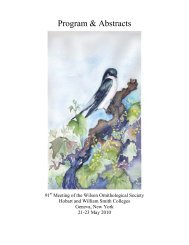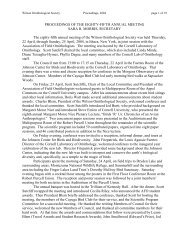avian ethogram and research project at the zoo - Wilson ...
avian ethogram and research project at the zoo - Wilson ...
avian ethogram and research project at the zoo - Wilson ...
Create successful ePaper yourself
Turn your PDF publications into a flip-book with our unique Google optimized e-Paper software.
4Figure 1. Some an<strong>at</strong>omical terms th<strong>at</strong> will be useful for referring to <strong>the</strong> external fe<strong>at</strong>ures ofbirds.METHODSGetting started on your subjectsChoose an active species. Try to be unobtrusive <strong>and</strong> quiet because your behavior may affect <strong>the</strong>birds’ activities. Stay close enough to see all <strong>the</strong> activities but not so close th<strong>at</strong> you disturb yoursubjects by your proximity or staring <strong>at</strong> <strong>the</strong>m or by any noise you make. They may flee orbecome immobile, nei<strong>the</strong>r of which is helpful for your d<strong>at</strong>a collection. They may becomehabitu<strong>at</strong>ed to your presence after some time <strong>and</strong> <strong>the</strong>n behave in <strong>the</strong>ir normal fashion even thoughaware of your presence. Describe <strong>the</strong> birds. Field guides in <strong>the</strong> library will be helpful. Diagram<strong>the</strong> habit<strong>at</strong>.After your description of <strong>the</strong> birds, you need to familiarize yourself with <strong>the</strong> behavioralrepertoire of your chosen species. Observing for an <strong>ethogram</strong> gives you <strong>the</strong> time <strong>and</strong> aframework in which to gain underst<strong>and</strong>ing of <strong>the</strong> animals by noting wh<strong>at</strong> <strong>the</strong>y do <strong>and</strong> how <strong>the</strong>ydo it. To get started, w<strong>at</strong>ch <strong>the</strong> birds for an hour <strong>and</strong> take notes of <strong>the</strong>ir different activities. In
5your field notebook, note <strong>the</strong> d<strong>at</strong>e <strong>and</strong> time, conditions such as we<strong>at</strong>her, crowd numbers, etc. <strong>and</strong><strong>the</strong>n keep track of <strong>the</strong> time <strong>and</strong> behavior you see. This is called AD LIB sampling, an informalnote-taking procedure of as many behavior p<strong>at</strong>terns as you see. You will be trying to describe <strong>at</strong>least a dozen. One student can describe <strong>the</strong> actions <strong>and</strong> <strong>the</strong> o<strong>the</strong>r can write <strong>the</strong>m down <strong>and</strong> time<strong>the</strong>m. The behavior may be motoric (e.g., flying <strong>and</strong> climbing, or concerned with bodymaintenance [feeding <strong>and</strong> elimin<strong>at</strong>ion, b<strong>at</strong>hing <strong>and</strong> preening] or explor<strong>at</strong>ory, such as searching orscanning, or social: affili<strong>at</strong>ive (friendly) or agonistic (thre<strong>at</strong>ening), or o<strong>the</strong>r behavior. Talk to <strong>the</strong>keepers. When are <strong>the</strong> birds most active? Consult two or three articles in scientific journalsabout <strong>the</strong> n<strong>at</strong>ural history of <strong>the</strong> species you have chosen. Then you are ready to begin your<strong>ethogram</strong>.Wh<strong>at</strong> is an <strong>ethogram</strong>?An <strong>ethogram</strong> is a c<strong>at</strong>alogue of <strong>the</strong> different action p<strong>at</strong>terns of your species such as thoselisted above. When you think you are familiar with many of <strong>the</strong> species behavior p<strong>at</strong>terns th<strong>at</strong>are repe<strong>at</strong>ed in <strong>the</strong>ir daily routine, start listing <strong>the</strong>se p<strong>at</strong>terns as you w<strong>at</strong>ch <strong>the</strong> animals. Try notto be subjective or label <strong>the</strong> p<strong>at</strong>terns <strong>at</strong> <strong>the</strong> beginning. Use descriptive names. Pretend th<strong>at</strong> youare describing your chosen species <strong>and</strong> its behavior to a Martian who has never seen <strong>the</strong> species.Write down careful descriptions of <strong>the</strong> movements so th<strong>at</strong> o<strong>the</strong>rs could read your descriptions<strong>and</strong> recognize those exact same movements. Exactly how was <strong>the</strong> movement done? Was <strong>the</strong>reany sound? (EXAMPLE: Open beak thrust. One bird is opening its beak <strong>and</strong> thrusting it in <strong>the</strong>direction of ano<strong>the</strong>r bird.) Is <strong>the</strong>re any movement of <strong>the</strong> rest of <strong>the</strong> body toward <strong>the</strong> o<strong>the</strong>r bird?Any change in <strong>the</strong> eyes or in <strong>the</strong> plumage? Any sound? Any o<strong>the</strong>r movement th<strong>at</strong> goes alongwith <strong>the</strong> open beak? The above behavior could be a begging movement by young or by a m<strong>at</strong>efor food or it may be a thre<strong>at</strong> display. Wh<strong>at</strong> was <strong>the</strong> context of <strong>the</strong> behavior? Your label for abehavior does not describe <strong>the</strong> behavior. If you call a behavior a “thre<strong>at</strong> behavior” th<strong>at</strong> labeldoes not tell us wh<strong>at</strong> <strong>the</strong> actions were; it tries to tell us something about <strong>the</strong> situ<strong>at</strong>ion, it passesjudgment on <strong>the</strong> action. One must exercise care in labeling behavior p<strong>at</strong>terns. Sometimes <strong>the</strong>movements may belong also to a different p<strong>at</strong>tern of behavior <strong>and</strong> <strong>the</strong>n <strong>the</strong>y may be done fordifferent reasons. So, try to keep a human bias out of your observ<strong>at</strong>ions in <strong>the</strong> beginning.Simply note th<strong>at</strong> one bird is opening its beak <strong>at</strong> ano<strong>the</strong>r <strong>and</strong> describe wh<strong>at</strong> happens. L<strong>at</strong>er, youcan label <strong>the</strong> behavior when you are more familiar with it <strong>and</strong> <strong>the</strong> context in which it isperformed.Using your list of behavior p<strong>at</strong>terns, you need to find out <strong>the</strong> frequency of those p<strong>at</strong>ternsin an hour’s time. For this type of record, you will use FOCAL ANIMAL SAMPLING. Youcannot record all activities of a group of animals <strong>at</strong> <strong>the</strong> same time, but you can get good behaviornotes on one animal for a short period of time. Be sure you can identify <strong>the</strong> one subject --howdoes it differ from <strong>the</strong> rest? Choosing a time when <strong>the</strong> animals will most likely be active,simply note how <strong>the</strong> activity is done <strong>and</strong> when it changes. Again, write down d<strong>at</strong>e, time <strong>and</strong>conditions <strong>and</strong> <strong>the</strong>n list behavior p<strong>at</strong>terns <strong>and</strong> times. Abbrevi<strong>at</strong>ions save time (feeding-FD), butprovide a key to your abbrevi<strong>at</strong>ions. Each person takes a turn <strong>at</strong> observing or recordingactivities until you have 3-4 hours of d<strong>at</strong>a so th<strong>at</strong> you can calcul<strong>at</strong>e <strong>the</strong> time your subjects spendon <strong>the</strong> activities you have listed in <strong>the</strong>ir behavioral repertoire.The teacher should check your <strong>ethogram</strong>s before you begin <strong>the</strong> <strong>research</strong> question part of
6<strong>the</strong> <strong>project</strong>. (No need to re-write all <strong>the</strong> descriptions if <strong>the</strong>y are legible.) You may need ac<strong>at</strong>egory for “O<strong>the</strong>r” behavior, such as some activity done when your subject is out of sight. Besure th<strong>at</strong> all <strong>the</strong> behavior p<strong>at</strong>terns you see will fit in one of your c<strong>at</strong>egories.How will you display <strong>the</strong> d<strong>at</strong>a?Using your d<strong>at</strong>a, make an activity chart with percentages of time devoted to each activity.ActivitySitYawnScr<strong>at</strong>chRummageE<strong>at</strong>/ChewBite BranchWalkLook <strong>at</strong> PeopleSt<strong>and</strong>StareRestBe GroomedGroom SelfMiscellaneousTimein minutes1082103717131331131124696Add up <strong>the</strong> time spent on each behaviorduring <strong>the</strong> time you w<strong>at</strong>ched yoursubjects. Then divide <strong>the</strong> number ofminutes spent in an activity by <strong>the</strong> totalnumber of minutes spent in all <strong>the</strong>observ<strong>at</strong>ions to get <strong>the</strong> percent of timespent on each activity. Make a PieChart of <strong>the</strong> percentages of time spent invarious activities so th<strong>at</strong> <strong>the</strong> observer canquickly underst<strong>and</strong> <strong>the</strong> interrel<strong>at</strong>ionshipsof <strong>the</strong> behavior p<strong>at</strong>terns <strong>and</strong> <strong>the</strong>ir rel<strong>at</strong>ivefrequency in <strong>the</strong> daily routine of <strong>the</strong>subject (Figure 2). The percentages on<strong>the</strong> Pie Chart should add up to 100%.PERCENT OF TIME IN ACTIVITY8%2%3%2% SITYAWNSCRATCH4%4%37%RUMMAGEEAT/CHEWBITE BRANCHWALKLOOK AT PEOPLE10%STANDINGSTARE4%4%6%12%3%1%RESTBEING GROOMEDGROOM SELFMISCELLANEOUSFigure 2. Pie Chart showing <strong>the</strong> proportion of time spent in each of <strong>the</strong> activities observed.So far, you have 1) chosen a species, 2) observed group activities, 3) observed individuals for <strong>at</strong>ime budget analysis, <strong>and</strong> 4) made activity charts <strong>and</strong> graphs. Now you are ready for <strong>the</strong>Research Project.
7Research <strong>project</strong>:Wh<strong>at</strong> is your hypo<strong>the</strong>sis?Figure out a question about behavior you have seen th<strong>at</strong> you can eventually answerthrough tallying more observ<strong>at</strong>ions. Wh<strong>at</strong> question do you want to study about your subject?These observ<strong>at</strong>ions will be taken on one or two animals <strong>and</strong> you will be looking for “ALLOCCURRENCES OF A SELECTED BEHAVIOR”, ano<strong>the</strong>r sampling method. Familiarizedwith your chosen species, you should design a simple <strong>research</strong> question, one th<strong>at</strong> you will be ableto answer with several more hours of d<strong>at</strong>a collection on <strong>the</strong> behavior in which you are interested.This question should be framed as a hypo<strong>the</strong>sis, a st<strong>at</strong>ement th<strong>at</strong> predicts a set of observ<strong>at</strong>ions.You should be able to test your hypo<strong>the</strong>sis with a limited set of d<strong>at</strong>a. Here are somepossibilities:(1) The question might concern time budgets: Is feeding intensity <strong>the</strong> same <strong>at</strong> noon as inl<strong>at</strong>e afternoon? You will <strong>the</strong>n suggest a tent<strong>at</strong>ive or “null hypo<strong>the</strong>sis” to be tested: There is nodifference between feeding intensity <strong>at</strong> noon <strong>and</strong> in l<strong>at</strong>e afternoon. The altern<strong>at</strong>ive hypo<strong>the</strong>sis:There is a significant difference between feeding intensities <strong>at</strong> noon <strong>and</strong> in l<strong>at</strong>e afternoon. Insuch a study, you may also want to consider comparing <strong>the</strong> <strong>zoo</strong> birds to wh<strong>at</strong> you observe offeeding behavior <strong>at</strong> your backyard feeder. Find out some of <strong>the</strong> factors th<strong>at</strong> determine how longa bird in <strong>the</strong> wild remains in one spot to feed.(2) Ano<strong>the</strong>r question might be compar<strong>at</strong>ive in n<strong>at</strong>ure: compare time spent on preeningbehavior (or o<strong>the</strong>r types of maintenance behavior) in two species. Null hypo<strong>the</strong>sis: There is nodifference in time spent preening in <strong>the</strong> ___ species <strong>and</strong> <strong>the</strong> ____species. Altern<strong>at</strong>ive hypo<strong>the</strong>sis:There is a significant difference ................ Describe preening. Wh<strong>at</strong> parts of <strong>the</strong> body arepreened? Why do birds preen? When? Is <strong>the</strong>re a precise timetable to preening? Do birds inyour species allopreen (preen o<strong>the</strong>rs)? Why would <strong>the</strong>y do this? Does one species preen moreoften but for shorter periods?(3) There is no difference in vocal <strong>and</strong> motor activity between male <strong>and</strong> female (species)(4) Do juveniles stay closer to each o<strong>the</strong>r than to <strong>the</strong>ir parents? (There is no difference inproximity of <strong>the</strong> juvenile to <strong>the</strong> mo<strong>the</strong>r than in proximity to <strong>the</strong> o<strong>the</strong>r young.)(5) Juveniles are more explor<strong>at</strong>ory (or playful or aggressive, etc.) than adults.(6) _____- (Parrot) species is left-footed (or right-footed) when feeding.Your hypo<strong>the</strong>sis will be supported by your d<strong>at</strong>a or disproved. If it is rejected (still a result!), <strong>the</strong>n<strong>the</strong> st<strong>at</strong>ement needs to be changed. Would more d<strong>at</strong>a be helpful? Wh<strong>at</strong> is your new hypo<strong>the</strong>sis?DISCUSSIONThe poster: How will you present <strong>the</strong> d<strong>at</strong>a?After you collect your d<strong>at</strong>a, tabul<strong>at</strong>e your results. You should calcul<strong>at</strong>e a st<strong>at</strong>isticalmeasure to determine if your findings can reject your null hypo<strong>the</strong>sis. For help on st<strong>at</strong>istics seeZar (1984) or Hailman <strong>and</strong> Strier (1997) for a short text on <strong>research</strong> writing <strong>and</strong> planning. Graphyour d<strong>at</strong>a. Do sketches or take pictures of <strong>the</strong> area <strong>and</strong> <strong>the</strong> birds.For <strong>the</strong> <strong>research</strong> <strong>project</strong>, you have (1) chosen your <strong>research</strong> question, (2) observedindividuals to g<strong>at</strong>her d<strong>at</strong>a, (3) analyzed th<strong>at</strong> d<strong>at</strong>a. Now you are ready to design your poster.Your finished poster (22” X 28” is appropri<strong>at</strong>e) should have 7 parts:
8(1) Title.(2) Abstract: a paragraph th<strong>at</strong> summarizes your <strong>research</strong> question <strong>and</strong> findings.(3) Methods: describe subjects, wh<strong>at</strong> you did for <strong>the</strong> <strong>project</strong>, where, how often, when.(4) Results: wh<strong>at</strong> you found. Include <strong>ethogram</strong>: one or two sentences to describe eachbehavior. Draw <strong>the</strong> time budget graph <strong>and</strong> chart <strong>and</strong> give any o<strong>the</strong>r d<strong>at</strong>a.(5) Discussion: Conclusions. Wh<strong>at</strong> would you do differently next time?(6) Brief n<strong>at</strong>ural history of subjects <strong>and</strong> bibliography of articles you read about your species.(7) Picture of birds <strong>and</strong> a diagram of <strong>the</strong> habit<strong>at</strong>.When you explain your poster to <strong>the</strong> class, you can tell <strong>the</strong>m any o<strong>the</strong>r inform<strong>at</strong>ion you learnedabout your species in your <strong>research</strong>.Figure 3. Sample layout for a poster. Notice <strong>the</strong> use of space, <strong>the</strong> use of pictures, <strong>and</strong> <strong>the</strong> limiteduse of text.Special TermsAD LIB (AD LIBITUM) sampling is an informal type of observ<strong>at</strong>ion <strong>and</strong> note-taking;describing all <strong>the</strong> activity th<strong>at</strong> is seen. This method is good <strong>at</strong> getting inform<strong>at</strong>ion on wh<strong>at</strong> leadsup to an event <strong>and</strong> wh<strong>at</strong> happens during <strong>and</strong> after <strong>the</strong> event. It is a first step in finding out all you
9can about <strong>the</strong> activities of various subjects.FOCAL ANIMAL SAMPLING concentr<strong>at</strong>es on getting all possible inform<strong>at</strong>ion about onesubject’s activities <strong>and</strong> how those activities are performed.SAMPLING ALL OCCURRENCES OF A SELECTED BEHAVIOR gives <strong>the</strong> viewer d<strong>at</strong>aon just <strong>the</strong> one behavior of interest to <strong>the</strong> observer.PIE CHART has each segment of <strong>the</strong> circle proportional to <strong>the</strong> frequency of a particularbehavior.ACKNOWLEDGEMENTSI thank Bob Shonk for <strong>the</strong> illustr<strong>at</strong>ion of morphological terms for birds <strong>and</strong> Rebecca Popovich<strong>and</strong> Ben Messmer for use of <strong>the</strong> activity charts of a mammal.REFERENCESAltmann, J. 1974. Observ<strong>at</strong>ional study of behavior: sampling methods. Behaviour 49:227-267.Hailman, J. P. <strong>and</strong> K. B. Strier. 1997. Planning, Proposing, <strong>and</strong> Presenting Science Effectively.Cambridge University Press, Cambridge.Washington Park Zoo <strong>and</strong> Minnesota Zoological Garden. 1947. Research methods for studyinganimal behavior in a <strong>zoo</strong> setting: Parts 1 <strong>and</strong> 2 {VHS}. University of Minnesota film <strong>and</strong>video c<strong>at</strong>alogue.Zar, Jerrold. 1984. Biost<strong>at</strong>istical Analysis. Prentice-Hall, Englewood Cliffs, NJ.ADDITIONAL SOURCESBrooks, R. <strong>and</strong> K. Yasakawa. Labor<strong>at</strong>ory exercises in animal behavior. K. Yasakawa:Department of Biology, Beloit College, Beloit, WI 53511.DeCoursey, P. 1994, July. A labor<strong>at</strong>ory exercise: <strong>zoo</strong> <strong>ethogram</strong>s. Paper presented <strong>at</strong> <strong>the</strong>Animal Behavior Society, Se<strong>at</strong>tle, WA.
SUGGESTIONS FOR INSTRUCTORS8
9The main campus of Roosevelt University is loc<strong>at</strong>ed a short bus ride from Lincoln ParkZoo in Chicago. Lincoln Park Zoo offers free admission to <strong>the</strong> public so students canreturn to observe <strong>the</strong>ir chosen subjects whenever <strong>the</strong>y want. If <strong>the</strong> <strong>zoo</strong> closest to yourschool does not have free admission, <strong>the</strong> instructor can very likely work out arrangementsfor a free pass for students for a limited time.This exercise could also be adapted for use in w<strong>at</strong>ching birds <strong>at</strong> bird-feeders or w<strong>at</strong>chingducks on a pond or pigeons in a park.Expenditures for this <strong>project</strong> consist of transport<strong>at</strong>ion <strong>and</strong> posterboard, perhaps somephotos of <strong>the</strong> animals <strong>and</strong> <strong>the</strong>ir enclosure.Students need to underst<strong>and</strong> <strong>the</strong> time requirements of this exercise. Figuring on groupsof 2, each pair should g<strong>at</strong>her 3-4 hours of d<strong>at</strong>a to compile for <strong>the</strong> <strong>ethogram</strong> activities <strong>and</strong><strong>the</strong>n <strong>the</strong> same amount of time for <strong>the</strong> <strong>research</strong> question. They’ll need to spend more timefinding o<strong>the</strong>r inform<strong>at</strong>ion on <strong>the</strong>ir chosen species <strong>and</strong> putting <strong>the</strong> d<strong>at</strong>a <strong>and</strong> results toge<strong>the</strong>r<strong>and</strong> deciding on st<strong>at</strong>istics <strong>and</strong> <strong>the</strong> design of <strong>the</strong> poster.Students should underst<strong>and</strong> th<strong>at</strong> <strong>the</strong> time budget of a captive animal is not <strong>the</strong> same asth<strong>at</strong> of a wild animal. This can be a part of a general discussion on <strong>zoo</strong>s: benefits <strong>zoo</strong>soffer (preserv<strong>at</strong>ion of rare <strong>and</strong> endangered species, <strong>the</strong> chance to view <strong>the</strong>se rareanimals) <strong>and</strong> problems (captivity <strong>and</strong> boredom, excess animals, breaking up m<strong>at</strong>ed pairsin order to increase <strong>the</strong>ir reproductive potential, etc.).Methods of d<strong>at</strong>a g<strong>at</strong>hering should be discussed. Would <strong>the</strong>y prefer to keep a runningcount of all behavior of one animal or do a “behavior scan” every minute or 30 seconds<strong>and</strong> record wh<strong>at</strong> <strong>the</strong> animal is doing <strong>at</strong> th<strong>at</strong> time? Interesting discussions could be basedon which method is better for getting dur<strong>at</strong>ion of a behavior or for getting unusualbehaviors, or c<strong>at</strong>ching a stimulus for a behavior. This exercise can introduce <strong>the</strong> manyways of sampling behavior. See discussion in Altmann (1974).A helpful video on <strong>ethogram</strong>s is from Washington Park Zoo (1947).Ethograms are often assigned in animal behavior courses <strong>and</strong> only th<strong>at</strong> part of <strong>the</strong>exercise may be done if time is short. When only <strong>the</strong> <strong>ethogram</strong> is used in <strong>the</strong> shortsession, students may work individually. They try to get an exhaustive c<strong>at</strong>alogue ofbehavior for <strong>the</strong>ir subject species <strong>and</strong> also loc<strong>at</strong>e resources on <strong>the</strong> n<strong>at</strong>ural history of th<strong>at</strong>species. A semester offers sufficient time to combine <strong>the</strong> <strong>ethogram</strong> with <strong>the</strong> <strong>research</strong>question. This combined exercise is an easy <strong>and</strong> enjoyable way to acquaint <strong>the</strong> non-Biology major with scientific investig<strong>at</strong>ion. I find th<strong>at</strong> <strong>the</strong> several parts of <strong>the</strong> <strong>project</strong> (<strong>the</strong><strong>ethogram</strong>, <strong>research</strong> <strong>project</strong>, oral present<strong>at</strong>ion, <strong>and</strong> <strong>the</strong> poster), also make it easier to grade.Students have enjoyed this <strong>research</strong> <strong>at</strong> <strong>the</strong> <strong>zoo</strong> <strong>and</strong> everyone seems very interested in <strong>the</strong>poster session <strong>at</strong> <strong>the</strong> end of <strong>the</strong> class.





